Epic Games team is well-known for its Fortnite game, which has been quite popular across the globe for years. As an online battle royale video game, Fortnite offers plenty of new features, weapons, characters, content, and more in every Chapter or Season. In the fourth chapter of Fortnite, players are having great fun. In Fortnite Chapter 4, players can ride a dirt bike, roll in a snowball, use Shockwave Hammer, etc., with the squad.
Well, there are some reasons behind Fortnite losing its grip and making users try their hand at any other same-category games. One of the main reasons behind this is audio lagging/not working or sound-cutting issues while playing the game. No one wants that in the middle of an intense match; the sound gets cut.
Meanwhile, after a few hours of research, our team found this issue was curable. That motivates us to bring up this guide and help those suffering from audio lagging/not working or sound-cutting issues in Fortnite. Therefore, without being late, let’s directly jump into the guide.
Also Read
What is Denial Reason Code 20 in Fortnite, How to Fix?
Fix: Fortnite Installation Failed Error
Complete Encrypted Cipher Quest Fortnite 19.11.2.20.22.5.20.8.4 and 22.13.1.4.19 – Dig at the Top of
Fix: Fortnite Unable to Sprint Bug
Free Fortnite Wildcat Skin Codes (Updated Daily)
Fortnite Account Generator 2023: Is it Real or Fake?
Fix: Fortnite Successfully Logged Out Error

Page Contents
- Fix: Fortnite Chapter 4 Audio Not Working or Crackling Sound Issue
- 1. Repair Game Files
- 2. Disable Nahimic Audio Driver
- 3. Update Audio Drivers
- 4. Reinstall Audio Drivers
- 5. Remove Fortnite Chapter 4 Config
- 6. Check the Wires of the Audio Output
- 7. Disconnect Other Peripherals
- 8. Test Out Other Speakers or Headsets
- 9. Power Cycle your PC
- 10. Turn Off Windows Sonic or Spatial Sound
- 11. Reset BIOS
- 12. Update BIOS
- 13: Disable The Audio Enhancements in Windows 11
- 15: Disable Full Screen Optimization & High DPI Scaling
- 16: Set Priority To Normal
Fix: Fortnite Chapter 4 Audio Not Working or Crackling Sound Issue
Affected players reported on Reddit that while playing on the console, the headset turned on, but they barely heard anything else. It seems like everything gets muffled and mixed with lower volume. It ruins the gameplay experience and nothing else. At the same time, some players have also mentioned that there is no issue with the headphones except for the speakers.
1. Repair Game Files
First, you should try repairing the game files in the Epic launcher or Steam client to check whether the problem has been fixed. Sometimes having some issues with corrupted or missing game files can be there. To do so:
Epic Users:
2. Disable Nahimic Audio Driver
Nahimic is an Audio Driver that your PC manufacturer selected to give you an optimized audio experience on laptops, motherboards, and more. It is a trusted driver designed to optimize and tune the audio performance on your computer.
- You’ll have to go to Task Manager (Ctrl+Shift+Esc) and head to Startup.
- Now, disable the Nahimic audio driver from the list.
- Finally, restart the computer to check whether the problem has been fixed.
3. Update Audio Drivers
It’s worth mentioning that Realtek Audio Driver users can head over to this article link to easily download and install the latest version of the audio driver for your specific motherboard or laptop model. Additionally, you can follow the steps below to update the active graphics driver on your Windows computer.
- Press the Windows + X keys to open the Quick Link Menu.
- Now, click on Device Manager to open it > Double-click on Sound, video, and game controllers.
- Right-click on the active or problematic audio device > Select Update driver.
- Click on Search automatically for drivers > Wait for the process to complete.
- If an update is available, the system will automatically check for it and install it.
- Once done, make sure to reboot the system to apply changes.
4. Reinstall Audio Drivers
Possibly, the audio driver on your computer has been corrupted or missing for some unexpected reason. Now, if you’re also feeling the same, make sure to reinstall audio drivers on the PC by following the steps below:
- Press the Windows + X keys to open the Quick Link Menu.
- Now, click on Device Manager to open it > Double-click on Sound, video, and game controllers.
- Right-click on the active or problematic audio device > Select Uninstall device.
- Click on Uninstall again to confirm the task > Wait for the process to be completed.
- Once done, make sure to restart your computer to apply changes.
- After the reboot, the Windows system will automatically reinstall the missing audio driver or device (if connected).
However, if it doesn’t get installed by the system automatically, then note down the computer model number or the motherboard model number and directly visit the official manufacturer’s website to download & install the latest audio driver.
5. Remove Fortnite Chapter 4 Config
You should try removing the Fortnite Chapter 4 Config file on your PC to check for the issue and whether it has been fixed or not. To do so:
- Head over to File Explorer (This PC) > Go to the C: drive (where you’ve installed the game).
- Now, go to the specific directory – username\documents\Fortnite Chapter 4\settings and delete the Fortnite Chapter 4 config file.
- Once done, reboot your PC to apply changes.
6. Check the Wires of the Audio Output
Check out the audio output device and wires to see whether they’re properly connected & plugged into the valid port. It’s quite a simple thing yet effective because sometimes users may forget or make mistakes a lot.
7. Disconnect Other Peripherals
It’s also worth mentioning disconnecting other peripherals to check for the issue again. Just try using a minimum number of external USB devices to ensure what’s causing the issue.
8. Test Out Other Speakers or Headsets
Make sure to test out other speakers or headsets with your computer while playing the Fortnite Chapter 4 game to check if there is an issue with your existing speaker or headset.
9. Power Cycle your PC
Sometimes performing a power cycle, your PC can fix multiple issues with the game. To do so:
- Make sure to power off the PC and unplug the power cable.
- Wait for around a minute and then power on the computer to check for the issue.
10. Turn Off Windows Sonic or Spatial Sound
If your desktop or laptop has the Windows Sonic or Spatial Sound feature, then make sure to disable it by following the steps below:
- Click on the Start menu > Go to Settings > Click on System.
- Now, click on Sound > Select Related settings.
- Go to Sound Control Panel and select a playback device.
- Next, select Properties > Select Spatial sound.
- In the Spatial Sound format, select Windows Sonic for Headphones.
- Finally, select Apply, and reboot the PC to change effects.
11. Reset BIOS
If resetting the overclock feature won’t work for you, ensure to try resetting the BIOS/UEFI menu as well. Using the same process, boot into the BIOS/UEFI menu. Then find the BIOS Settings Reset or Default BIOS Setup and select it to confirm. Once done, restart your PC.
12. Update BIOS
Plenty of shortcuts and in-depth tutorials are available online to safely update your Windows system BIOS/UEFI according to your motherboard brand without any issue. Like the Windows update, BIOS update is also useful and necessary to fix many crashes or errors.
That’s it, guys. We assume this guide was helpful to you. For further queries, you can comment below.
13: Disable The Audio Enhancements in Windows 11
As we know, the audio enhancement in Windows 11 is used to enhance your audio performance. But, sometimes, this may come up as the main reason behind each issue you are facing regarding the audio or sound in your PC. So, if each try goes in vain, try the steps we have mentioned below to disable the audio enhancements in your Windows 11 PC. Therefore, let’s take a look at them:
- Initially, right-click on the volume icon in the window’s bottom right corner.
- Then, select the Open Sound Settings and click on the Sound Control Panel.
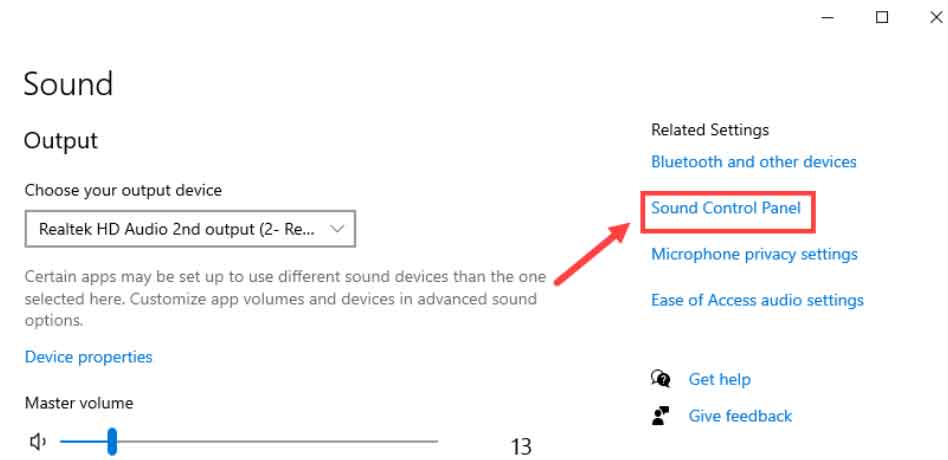
- Now, switch to the Playback tab, double-click on the device you are using and hit the Properties button.
- After that, shift to the Enhancements tab and checkmark the box located in front of the Disable all enhancements.
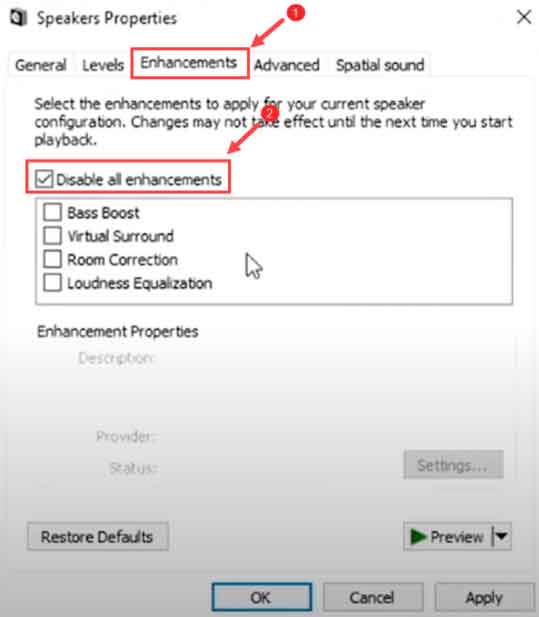
- Then, shift to the Advanced tab. After clicking on the drop-down menu, choose the 16 bit, 44100 Hz (CD Quality).
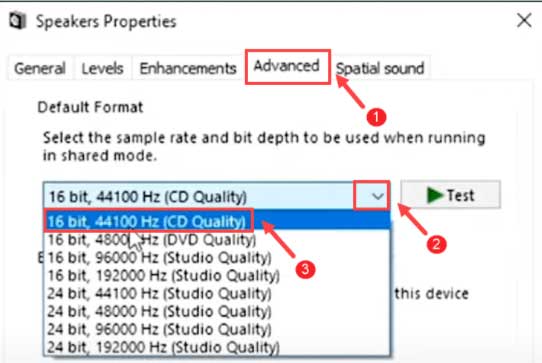
15: Disable Full Screen Optimization & High DPI Scaling
If you have enabled the full-screen optimization & high DPI scaling on your Windows 11 PC, then we recommend you disable these options. Many users reported that this aid them fix audio lagging or not working issues on Fortnite. However, you do not require to worry if you don’t familiar with the exact way to do this because we have mentioned all the necessary steps down below:
- First of all, navigate to the: C: drive > Program Files > Epic Games > Fortnite > Binaries > Win64.
- Now, locate FortniteClient-Win64-Shipping.dll and right-click on it.
- Then, from the drop-down list, choose the Properties option.
- After that, shift to the compatibility tab and checkmark the box located in front of Disable fullscreen optimizations.
- Now, simply click on the Change high DPI settings option.
- After that, checkmark the box located in front of the Override high DPI scaling behavior.
- Finally, hit the Ok button. Then, tap on the Apply button followed by OK.
So, that’s it. Now, you can do the same process for FortniteClient-Win64-Shipping_BE, FortniteClient-Win64-Shipping_EAC, and FortniteLauncher.
Also Read: Fix: Fortnite Chapter 3 Crashing on PS4, PS5, Xbox, or Switch Guide
16: Set Priority To Normal
If the audio not working issue is occurring in-game, then you need to make sure that the game is set to normal priority setting. So, in case you don’t know how to do that, follow the steps we have mentioned below:
- Firstly, you need to open the Run Prompt box and search for the taskmgr. This will open the Task Manager.
- After that, switch to the Processes tab and locate the Fortnite app.
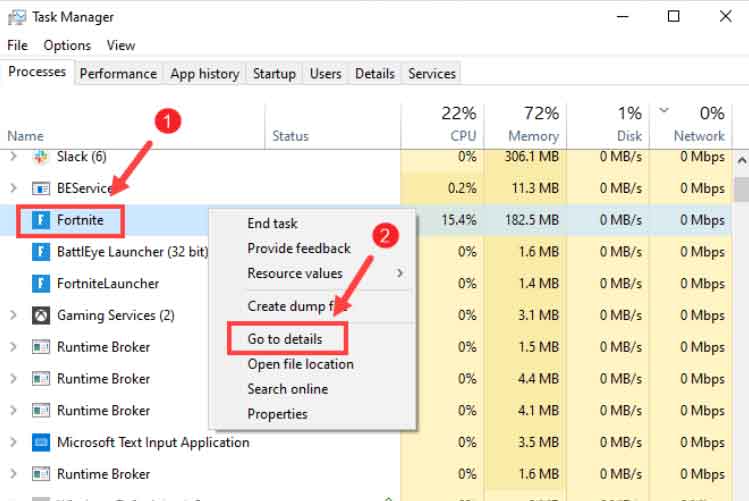
- Then, right-click on it and click on the go to details option.
- Now, you will be directed to the Detail tab. There the FortniteClient-Win64 will be highlighted.
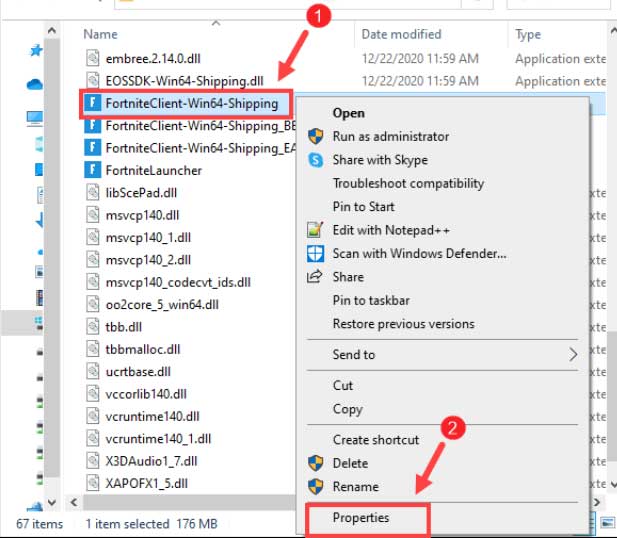
- So, you need to right-click on it, click on the Set Priority option, and set it to normal.
So, that’s it from our side on how to fix Fortnite audio lagging/not working or sound cutting issues. We hope this guide has helped you. However, for more info and your queries, comment below.
